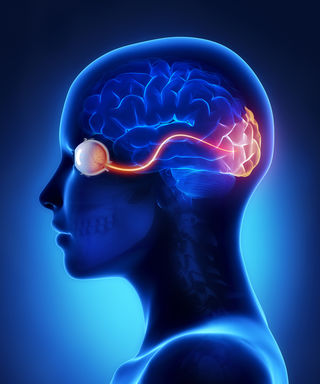Low-Intensity Aerobic Exercise Has Surprising Brain Benefits
Low-Intensity Aerobic Exercise Has Surprising Brain Benefits
Low-intensity exercise stimulates the visual cortex and sensitizes human vision.

Eye and visual cortex nerves.
Source: CLIPAREA l Custom media/Shutterstock
The February 2017 study, "Acute Exercise Modulates Feature-Selective Responses in Human Cortex," was published yesterday in the Journal of Cognitive Neuroscience.
Any organism's current behavioral state influences brain activity and perceptions of the environment. But, how do various intensities of physical activity influence the human brain? Is moderate-to-vigorous physical activity (MVPA) always the most effective way to dynamize the brain benefits of exercise? Or does low-intensity exercise have significant brain benefits, too?
Because of the prescriptive importance of answering these questions, neuroscientific research continues making strides to pinpoint clear-cut brain benefits of various intensities of aerobic exercise. Interestingly, in the past week, two different studies have identified that low-intensity physical activity appears to have specific brain benefits that have gone under the radar until now.
Earlier this week, researchers in Denmark reported that lower intensity physical activities improve math performance for first graders when motor-enriched learning is integrated into the classroom. Contrary to previous hypotheses, the Danish researchers found that low-intensity exercise may be more beneficial to academic learning than high-intensity aerobic activity for some children.
In the aforementioned study on visual processing, UC Santa Barbara psychology and brain scientists Barry Giesbrecht and Tom Bullock from the UCSB Attention Lab recruited 18 volunteers to test the link between various intensities of physical activity and brain activity.
During the experiment, participants rode a stationary bicycle at varying aerobic intensities while wearing an EEG cap to monitor brain activity as they performed a variety of visual discrimination tasks. Visual tasks were performed while resting and during bike intervals at both low- and high-intensity output.
As noted earlier, neurons in the visual cortex became most sensitive to visual stimuli during the low-intensity exercise condition relative to both other conditions.
Locomotion Enhances Visual Perception Across Species, Including Humans

Source: Chetty Thomas/Shutterstock
A wide range of previous studies have found that during any type of locomotion, there is a spike in neural responses within the sensory cortex of invertebrates and nonhuman mammals.
Although there are significant differences in the structure of visual pathways in various species, this UCSB study provides empirical evidence that neural mechanisms in the human visual cortex are stimulated by locomotive behavior. Exercise-induced enhancement of visual processing appears to occur across species, including humans.
Based on our evolutionary and neurobiological roots, it would make sense that our hunter-gatherer ancestors relied on enhanced visual processing during all forms of locomotion as they traversed diverse landscapes hunting for prey and scavenging for food.
In a statement, co-author Barry Giesbrecht, professor in UCSB's Department of Psychological and Brain Sciences, touched on the evolutionary roots linking locomotion and enhanced visual processing.
In recent years, countless studies have illuminated the widespread brain benefits of moderate to vigorous physical activity. Now, there is growing evidence that low-intensity physical activity also has significant brain benefits that require further investigation.
"There’s an interesting cross-species link that shows these effects of arousal might have similar consequences for how visual information is processed. That implies the evolution of something that might provide a competitive advantage in some way.”The latest research from UCSB's Attention Lab underscores the importance of physical activity in a fresh light. As Giesbrecht concluded, "The benefits of brief bouts of exercise might provide a better and more tractable way to influence information processing—versus, say, brain training games or meditation—and in a way that's not tied to a particular task."
In recent years, countless studies have illuminated the widespread brain benefits of moderate to vigorous physical activity. Now, there is growing evidence that low-intensity physical activity also has significant brain benefits that require further investigation.

